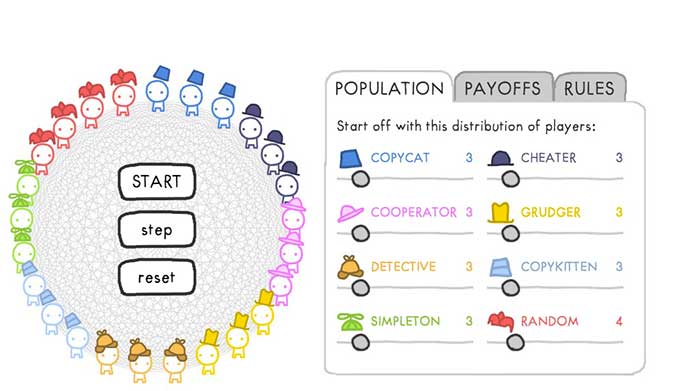
This simulation, called The Evolution of Trust starts with a variation of the prisoners' dilemma. You can choose to put a coin into a slot. Another person has the same choice on a different machine. You can't communicate with the other person. The only thing you know is this: if the other person put a coin in their slot, you will receive 3 coins. And if you put a coin in your slot, the other person will get 3 coins. What's the best strategy?
Trust is falling. Why? And how can we fix it?
— Nicky Case (@ncasenmare) July 25, 2017
My interactive guide to the game theory of trust is now OUT!
👉 https://t.co/2x7BfWehpJ 👈 pic.twitter.com/AjDBJ0w6OB
Case 1: other person inserts coin. If you put a coin in the slot, you will have a net gain of 2 coins. If you don't put a coin in the slot you will gain 3 coins. So the best thing to do is not put a coin in the slot.
Case 2: other person doesn't insert coin. If you put a coin in the slot, you will have a net loss of 1 coin. If you don't put a coin in the slot you lose nothing. So the best thing to do is not put a coin in the slot.
In either case, it's to your advantage not to put a coin in the slot. But what happens when you play several rounds of the game with the same person? Are there better strategies? Yes, and this excellent interactive simulation by Nicky Case walks you through them in an entertaining way. It's a great introduction to game theory. 
From the simulation:
Game theory has shown us the three things we need for the evolution of trust:
1. REPEAT INTERACTIONS Trust keeps a relationship going, but you need the knowledge of possible future repeat interactions before trust can evolve.
2. POSSIBLE WIN-WINS You must be playing a non-zero-sum game, a game where it's at least possible that both players can be better off -- a win-win.
3. LOW MISCOMMUNICATION The level of miscommunication can't be too high. And when there's a little bit of miscommunication, it pays to be more forgiving.
Our problem today isn't just that people are losing trust, it's that our environment acts against the evolution of trust.